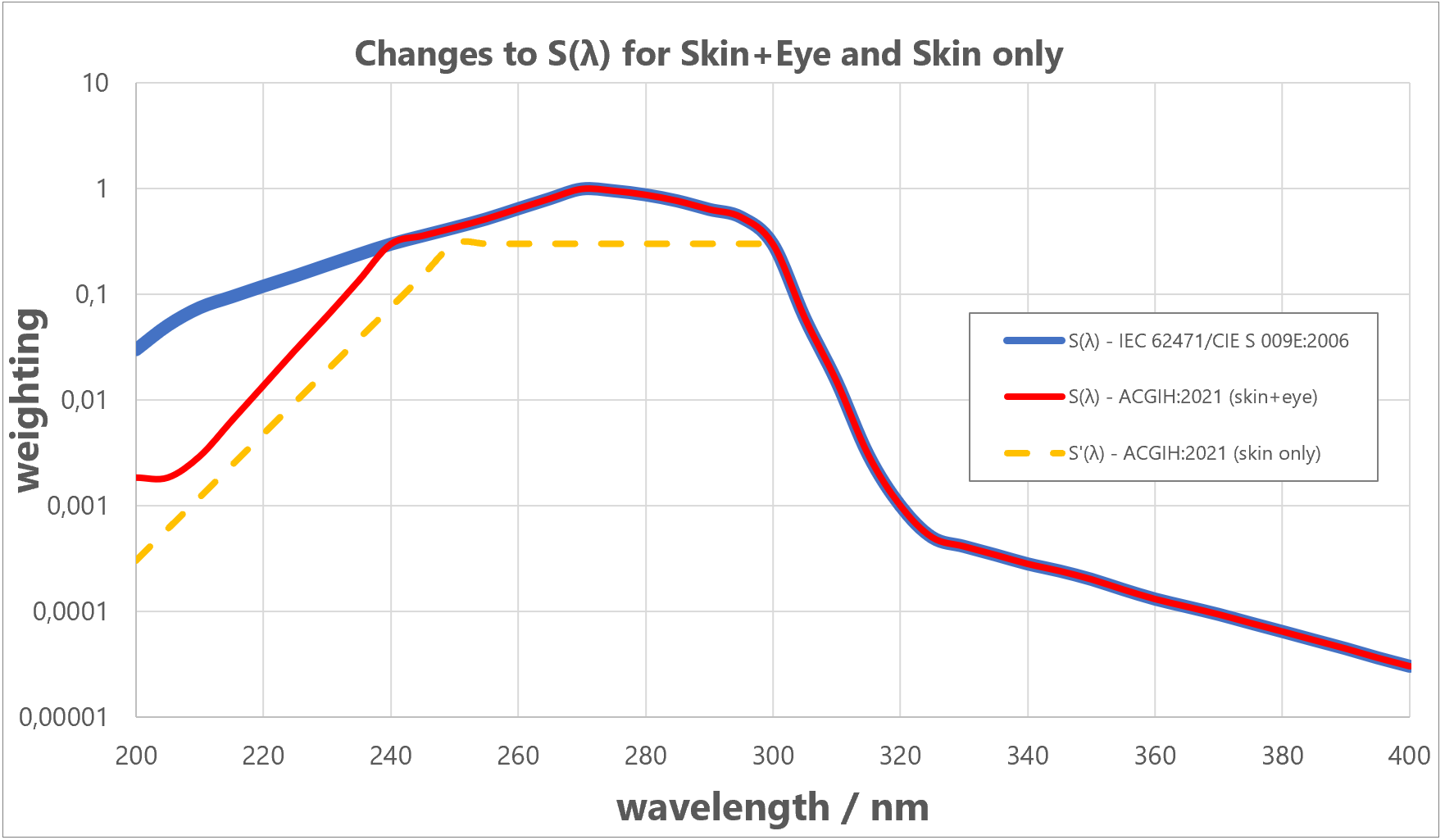
Standards about Germicidal UV Radiation
When analyzing the existing norms/standards, one finds that most standards relate to the potential hazard of UVC sources (photobiological safety) rather than to the germicidal effectiveness (germicidal efficacy) of UVC light sources. In general, they are based on ICNIRP guidelines on the limits of exposure to ultraviolet radiation, published in HEALTH PHYSICS 87(2):171-186; 2004.
We at Gigahertz Optik GmbH have a variety of different measurement instruments to meet these requirements of the standards. In particular, detection limit, SNR, calibration strategy related to the radiation source to be measured as well as weighting functions are to be mentioned here. Discover e.g. our UVC Radiometers, our Light Hazard Meters or our Spectroradiometers for Light Hazard.
General UVC Safety Standards
IEC 62471:2006 Photobiological safety of lamps and lamp systems. Specifies the exposure limits, reference measurement technique and classification scheme for the evaluation of photobiological hazards from all electrically powered incoherent broadband sources of optical radiation, in the wavelength range from 200 nm through 3000 nm. Dual logo standard with CIE S009:2002.
EN 62471:2008 is a horizontal standard – harmonised within Europe (CENELEC recognised) within the Low Voltage Directive, 2014/35/EU. Therefore, CE marking of products (LVD compliance) requires the consideration of optical radiation safety. It applies where no vertical standard exists.
Exposure limits within EN 62471 are set by the EU Artificial Optical Radiation Directive, 2006/25/EC. This directive aims to protect workers (eyes and skin) from exposure to hazardous sources of artificial optical radiation, but excludes sunlight. 2006/25/EC refers to EN 62471 for the evaluation of non-laser sources and EN 60825 for laser sources. There is currently only one minor difference between EN 62471 and IEC 62471.
The USA standard in the field of photobiological safety is ANSI IESNA RP 27, but it is only a voluntary standard. There are no regulatory UV radiation exposure limits.
The American Conference of Governmental Industrial Hygienists (ACGIH) publishes Threshold Limit Values (TLVs). The ACGIH 2021 includes ‘Notice of intended change’ to UVC TLVs as a result of proposed changes to actinic UV weighting function.
VDE 0837-471:2009-03 is the German language version of EN 62471:2008.
BIS IS 16108:2012 This Indian standard, published in 2012, is identical to IEC 62471.
JIS C 7550:2011 Japanese standard, Photobiological safety of lamps and lamp systems has some differences to IEC 62471
Germicidal UVC Product / Application Standards
DIN/TS 67506 Disinfection of room air with UV radiation - UV-C secondary air units. Provides comprehensive information on the mode of action and hazard potential of UV radiation in secondary air sterilisers. The recommended radiation doses for the inactivation of viruses and microorganisms are given. These conditions directly result in requirements for the design of room air disinfectors. Procedures and methods for demonstrating the effectiveness of UV radiation are named. The devices described should be suitable for use while people are in the room. For this reason, the detection and measurement of residual emissions or remaining emission and their limit values are also described in DIN/TS 67506.
VDI - EE 4300-14 Measurement of indoor pollution - Requirements for mobile air purifiers to reduce aerosol-borne transmission of infectious diseases
IEC 60335-2-65:2002+A1:2008+A2:2015 Particular requirements for air-cleaning appliances. Deals with the safety of electric air-cleaning appliances for household purposes. Also includes appliances intended to be used by laymen in shops, in light industry and on farms.
ISO 15858:2016 specifies minimum human safety requirements for the use of UVC lamp devices. It is applicable to in-duct UVC systems, upper-air in room UVC systems, portable in-room disinfection UVC devices, and any other UVC devices which may cause UVC exposure to humans. It is not applicable to UVC products used for water disinfection.
ASHRAE 185.1-2020 Method of Testing UV-C Lights for Use in Air-Handling Units or Air Ducts to Inactivate Airborne Microorganisms (ANSI Approved). Establishes a test method to evaluate UV-C lamps for their ability to inactivate airborne microorganisms. It defines procedures for generating test bioaerosols and for sampling upstream and downstream of the UV-C lamp. In addition, the standard establishes performance specifications for test equipment, quality assurance standards, and methods of calculating and reporting results from the test data.
ASHRAE 185.2-2020 Method of Testing Ultraviolet Lamps for Use in HVAC&R Units or Air Ducts to Inactivate Microorganisms on Irradiated Surfaces (ANSI Approved). Establishes a test method to measure the intensity of ultraviolet (UV-C) lamps on irradiated surfaces under typical HVAC&R operating conditions. It also defines methods of calculating and reporting results obtained from the test data.
ÖNORM M 5873-1:2020 Devices for the disinfection of water using ultraviolet radiation Part 1: Devices equipped with UV low pressure lamps - Requirements and testing
DIN 19294-1:2020 Devices for the disinfection of water using ultraviolet radiation - Part 1: Devices equipped with UV low pressure lamps - Requirements and testing
IEC 60335-2-109:2010+A1:2013+A2:2016 Particular requirements for UV radiation water treatment appliances. Deals with the safety of UV radiation water treatment appliances for household and similar purposes. Appliances intended to be used by laymen in shops and in light industry and farms, are also within the scope of this standard.
+49 (8193) 93 700-0